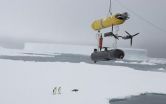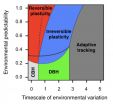(Press-News.org) Patients who had cardiac arrest at home or elsewhere outside of a hospital had greater survival to hospital discharge and to 90 days beyond if they received basic life support (BLS) vs. advanced life support (ALS) from ambulance personnel, according to a report published online by JAMA Internal Medicine.
Emergency medical services (EMS) respond to an estimated 380,000 cardiac arrests that happen annually out of the hospital. ALS providers, or paramedics, are trained to use sophisticated, invasive interventions (such as intubation - the placement of a breathing tube) to treat cardiac arrest before the patient arrives at the hospital. BLS providers, or emergency medical technicians, use simpler devices such as bag valve masks (hand-operated mask that helps breathe for the patient) and automated external defibrillators. Consequently, ALS paramedics tend to spend more time at the location of a cardiac arrest than BLS personnel.
Prachi Sanghavi, B.S., of Harvard University, Boston, and colleagues used data from a nationally representative sample of Medicare beneficiaries from nonrural counties in the United States who had out-of-hospital cardiac arrest between January 2009 and October 2011 for whom ALS or BLS ambulance services were charged to Medicare. There were 31,292 ALS cases and 1,643 BLS cases. Researchers primarily examined patient survival to hospital discharge, to 30 days and to 90 days.
The results show survival to hospital discharge was greater among patients receiving BLS (13.1 percent vs. 9.2 percent for ALS) and so was survival to 90 days postdischarge (8.0 percent vs. 5.4 percent for ALS). Rates of poorer neurological functioning were lower for hospitalized patients who received BLS (21.8 percent vs. 44.8 percent with poor neurological function for ALS). Results suggest the difference in survival between ALS and BLS is explained by higher mortality in the first few days after cardiac arrest for patients who received ALS.
"Our study calls into question the widespread assumption that advanced prehospital care improves outcomes of out-of-hospital cardiac arrest relative to care following the principles of BLS, including rapid transport and basic interventions such as effective chest compressions, bag valve mask ventilation and automated external defibrillation. It is crucial to evaluate BLS and ALS use in other diagnosis groups and setting and to investigate the clinical mechanisms behind our results to identify the most effective prehospital care strategies for saving lives and improving quality of life conditional on survival," the study concludes.
INFORMATION:
(JAMA Intern Med. Published online November 24, 2014. doi:10.1001/jamainternmed.2014.5420. Available pre-embargo to the media at http://media.jamanetwork.com.)
Editor's Note: An author made a conflict of interest disclosure. Authors disclosed funding/support. Please see the article for additional information, including other authors, author contributions and affiliations, financial disclosures, funding and support, etc.
Commentary: Evidence in Support of Back-to-Basics Approach
In a related commentary, Michael Callaham, M.D., of the University of California, San Francisco, writes: "In sum, is it possible that basic life support (BLS) - using automatic defibrillators, cardiopulmonary resuscitation and airway management without intubation - could be as good or better?"
"Sanghavi et al provide us with provocative data in answer to this question in this issue of JAMA Internal Medicine. ... The study by Sanghavi et al uses a different methodology than most previous studies of prehospital care; the population and analysis were based on billings for level of emergency medical system (EMS) response, rather than from clinical records of presentation and treatment at the scene," Callaham notes.
"Most ALS interventions are 'advanced' chiefly in our expectations, not in evidence-based efficacy. It is time instead to perfect and consistently prioritize all the proven basics, all the time," the author concludes.
(JAMA Intern Med. Published online November 24, 2014. doi:10.1001/jamainternmed.2014.6590. Available pre-embargo to the media at http://media.jamanetwork.com.)
Editor's Note: Please see the article for additional information, including other authors, author contributions and affiliations, financial disclosures, funding and support, etc.
Media Advisory: To contact author Prachi Sanghavi, B.S., call Angela Alberti at 617-432-3038 or email Angela_Alberti@hms.harvard.edu. To contact commentary author Michael Callaham, M.D., call Elizabeth Fernandez at 415-514-1592 or email efernandez@pubaff.ucsf.edu
SAN ANTONIO (Nov. 24, 2014) -- HIV-1-infected U.S. military members and beneficiaries treated with antiretroviral therapy (ART) soon after infection were half as likely to develop AIDS and were more likely to reconstitute their immune-fighting CD4+ T-cells to normal levels, researchers reported Nov. 24 in JAMA Internal Medicine.
Other immune benefits of starting treatment early and reaching a normal CD4+ T-cell count on therapy were also reported, including reductions in the activation state of T-cells, which influences HIV disease course, and improvements in the ability ...
MADISON, Wis. -- Sixty years ago, the plows ended their reign and the fields were allowed to return to nature -- allowed to become the woodland forests they once were.
But even now, the ghosts of land-use past haunt these woods. New research by Philip Hahn and John Orrock at the University of Wisconsin-Madison on the recovery of South Carolina longleaf pine woodlands once used for cropland shows just how long lasting the legacy of agriculture can be in the recovery of natural places.
By comparing grasshoppers found at woodland sites once used for agriculture to similar ...
UCLA neurophysicists have found that space-mapping neurons in the brain react differently to virtual reality than they do to real-world environments. Their findings could be significant for people who use virtual reality for gaming, military, commercial, scientific or other purposes.
"The pattern of activity in a brain region involved in spatial learning in the virtual world is completely different than when it processes activity in the real world," said Mayank Mehta, a UCLA professor of physics, neurology and neurobiology in the UCLA College and the study's senior author. ...
Single-cell phytoplankton in the ocean are responsible for roughly half of global oxygen production, despite vast tracts of the open ocean that are devoid of life-sustaining nutrients. While phytoplankton's ability to adjust their physiology to exploit limited nutrients in the open ocean has been well documented, little is understood about how variations in microbial biodiversity -- the number and variety of marine microbes - affects global ocean function.
In a paper published in PNAS on Monday November 24, scientists laid out a robust new framework based on in situ observations ...
DURHAM, N.C. -- Nearly four decades of observations of Tanzanian chimpanzees has revealed that the mothers of sons are about 25 percent more social than the mothers of daughters. Boy moms were found to spend about two hours more per day with other chimpanzees than the girl moms did.
Chimpanzees have a male-dominated society in which rank is a constant struggle and females with infants might face physical violence and even infanticide. It would be safer in general to just avoid groups where aggressive males are present, yet the mothers of sons choose to do so anyway.
"It ...
A National Science Foundation (NSF)-funded research team has successfully tested an autonomous underwater vehicle, AUV, that can produce high-resolution, three-dimensional maps of Antarctic sea ice. SeaBED, as the vehicle is known, measured and mapped the underside of sea-ice floes in three areas off the Antarctic Peninsula that were previously inaccessible.
The results of the research were published this week in the journal Nature Geoscience. Scientists at the Institute of Antarctic and Marine Science (Australia), Antarctic Climate and Ecosystem Cooperative Research ...
Coral reefs persist in a balance between reef construction and reef breakdown. As corals grow, they construct the complex calcium carbonate framework that provides habitat for fish and other reef organisms. Simultaneously, bioeroders, such as parrotfish and boring marine worms, breakdown the reef structure into rubble and the sand that nourishes our beaches. For reefs to persist, rates of reef construction must exceed reef breakdown. This balance is threatened by increasing atmospheric carbon dioxide, which causes ocean acidification (decreasing ocean pH). Prior research ...
LIND, Wash. - In the world's driest rainfed wheat region, Washington State University researchers have identified summer fallow management practices that can make all the difference for farmers, water and soil conservation, and air quality.
Wheat growers in the Horse Heaven Hills of south-central Washington farm with an average of 6-8 inches of rain a year. Wind erosion has caused blowing dust that exceeded federal air quality standards 20 times in the past 10 years.
"Some of these events caused complete brown outs, zero visibility, closed freeways," said WSU research ...
Researchers from North Carolina State University have created a model that mimics how differently adapted populations may respond to rapid climate change. Their findings demonstrate that depending on a population's adaptive strategy, even tiny changes in climate variability can create a "tipping point" that sends the population into extinction.
Carlos Botero, postdoctoral fellow with the Initiative on Biological Complexity and the Southeast Climate Science Center at NC State and assistant professor of biology at Washington State University, wanted to find out how diverse ...
Last year, University of Pennsylvania researchers Alexander J. Stewart and Joshua B. Plotkin published a mathematical explanation for why cooperation and generosity have evolved in nature. Using the classical game theory match-up known as the Prisoner's Dilemma, they found that generous strategies were the only ones that could persist and succeed in a multi-player, iterated version of the game over the long term.
But now they've come out with a somewhat less rosy view of evolution. With a new analysis of the Prisoner's Dilemma played in a large, evolving population, they ...




